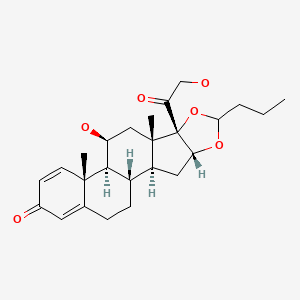Attribution Statement: LactMed is a registered trademark of the U.S. Department of Health and Human Services.
NCBI Bookshelf. A service of the National Library of Medicine, National Institutes of Health.
Drugs and Lactation Database (LactMed®) [Internet]. Bethesda (MD): National Institute of Child Health and Human Development; 2006-.
CASRN: 51333-22-3

Drug Levels and Effects
Summary of Use during Lactation
The amounts of inhaled budesonide excreted into breastmilk are minute and infant exposure is negligible. When taken by mouth, budesonide is only about 9% bioavailable; bioavailability in the infant is likely to be similarly low for any budesonide that enters the breastmilk. Expert opinion considers inhaled, nasal, oral and rectal corticosteroids acceptable to use during breastfeeding.[1-3]
Drug Levels
Maternal Levels. The manufacturer reports that the maximum budesonide plasma concentration following a 9 mg daily dose in both single- and repeated-dose pharmacokinetic studies of oral budesonide ranges from 2.15 to 4.31 mcg/L, which is 10 times higher than with inhaled budesonide. With rectal budesonide, maternal serum levels are about 0.4 mcg/L. Inhaled budesonide results in a relative infant dose of 0.3%, so the oral dose could provide an oral weight-adjusted dose of 3% to a breastfed infant. However, since the drug is only about 9% absorbed orally, the infant’s systemic RID after maternal oral use would be about 0.27%. The RID after rectal budesonide would be about 0.025%.
Eight women with asthma were using inhaled budesonide 200 mcg (n = 4) or 400 mcg twice daily (n = 4) by Pulmicort Turbihaler. Peak milk levels of budesonide of 168 ng/L and 335 ng/L occurred at 32 and 43 minutes after inhalation with the 200 mcg and 400 mcg doses, respectively. Average infant doses were estimated to be 6.8 and 14.2 ng/kg daily for the 200 mcg and 400 mcg dosages. A fully breastfed infant would receive a maximum of 0.3% of the weight-adjusted maternal dosage, assuming 100% oral bioavailability from breastmilk.[4]
Infant Levels. Four infants whose mothers were taking budesonide 200 mcg (n = 2) or 400 mcg (n = 2) twice daily by Pulmicort Turbihaler. The infants had serum samples taken 1.5 hours (range 0.7 to 2 hours) after the first breastfeeding after drug administration and 2.3 hours (range 2.1 to 2.6 hours) after maternal drug inhalation. All had undetectable (<8.6 to 17.2 ng/L) serum budesonide concentrations.[4]
Effects in Breastfed Infants
None reported with any corticosteroid.
Effects on Lactation and Breastmilk
Relevant published information was not found as of the revision date.
Alternate Drugs to Consider
(Inhalation) Beclomethasone
References
- 1.
- National Heart, Lung, and Blood, Institute, National Asthma, Education, and, Prevention, Program, Asthma, and, Pregnancy, Working, Group. NAEPP expert panel report. Managing asthma during pregnancy: recommendations for pharmacologic treatment-2004 update. J Allergy Clin Immunol 2005;115:34-46. [PubMed: 15637545]
- 2.
- Middleton PG, Gade EJ, Aguilera C, et al. ERS/TSANZ Task Force Statement on the management of reproduction and pregnancy in women with airways diseases. Eur Respir J 2020;55:1901208. [PubMed: 31699837]
- 3.
- McConnell RA, Mahadevan U. Pregnancy and the patient with inflammatory bowel disease: Fertility, treatment, delivery, and complications. Gastroenterol Clin North Am 2016;45:285-301. [PubMed: 27261899]
- 4.
- Fält A, Bengtsson T, Kennedy BM, et al. Exposure of infants to budesonide through breast milk of asthmatic mothers. J Allergy Clin Immunol 2007;120:798-802. [PubMed: 17825891]
Substance Identification
Substance Name
Budesonide
CAS Registry Number
51333-22-3
Drug Class
Breast Feeding
Lactation
Milk, Human
Anti-Asthmatic Agents
Corticosteroids, Inhaled
Anti-allergic Agents
Corticosteroids, Systemic
Glucocorticoids
Anti-Inflammatory Agents
Disclaimer: Information presented in this database is not meant as a substitute for professional judgment. You should consult your healthcare provider for breastfeeding advice related to your particular situation. The U.S. government does not warrant or assume any liability or responsibility for the accuracy or completeness of the information on this Site.
- User and Medical Advice Disclaimer
- Drugs and Lactation Database (LactMed) - Record Format
- LactMed - Database Creation and Peer Review Process
- Fact Sheet. Drugs and Lactation Database (LactMed)
- Drugs and Lactation Database (LactMed) - Glossary
- LactMed Selected References
- Drugs and Lactation Database (LactMed) - About Dietary Supplements
- Breastfeeding Links
- PubChem SubstanceRelated PubChem Substances
- PubMedLinks to PubMed
- Review Flunisolide.[Drugs and Lactation Database (...]Review Flunisolide.. Drugs and Lactation Database (LactMed®). 2006
- Review Lovastatin.[Drugs and Lactation Database (...]Review Lovastatin.. Drugs and Lactation Database (LactMed®). 2006
- Review Triamcinolone.[Drugs and Lactation Database (...]Review Triamcinolone.. Drugs and Lactation Database (LactMed®). 2006
- Bioavailability profile of Uceris MMX extended-release tablets compared with Entocort EC capsules in healthy volunteers.[J Int Med Res. 2013]Bioavailability profile of Uceris MMX extended-release tablets compared with Entocort EC capsules in healthy volunteers.Nicholls A, Harris-Collazo R, Huang M, Hardiman Y, Jones R, Moro L. J Int Med Res. 2013 Apr; 41(2):386-94. Epub 2013 Mar 7.
- Review Beclomethasone.[Drugs and Lactation Database (...]Review Beclomethasone.. Drugs and Lactation Database (LactMed®). 2006
- Budesonide - Drugs and Lactation Database (LactMed®)Budesonide - Drugs and Lactation Database (LactMed®)
- ZNF518A zinc finger protein 518A [Homo sapiens]ZNF518A zinc finger protein 518A [Homo sapiens]Gene ID:9849Gene
- Gene Links for GEO Profiles (Select 131590038) (1)Gene
Your browsing activity is empty.
Activity recording is turned off.
See more...
